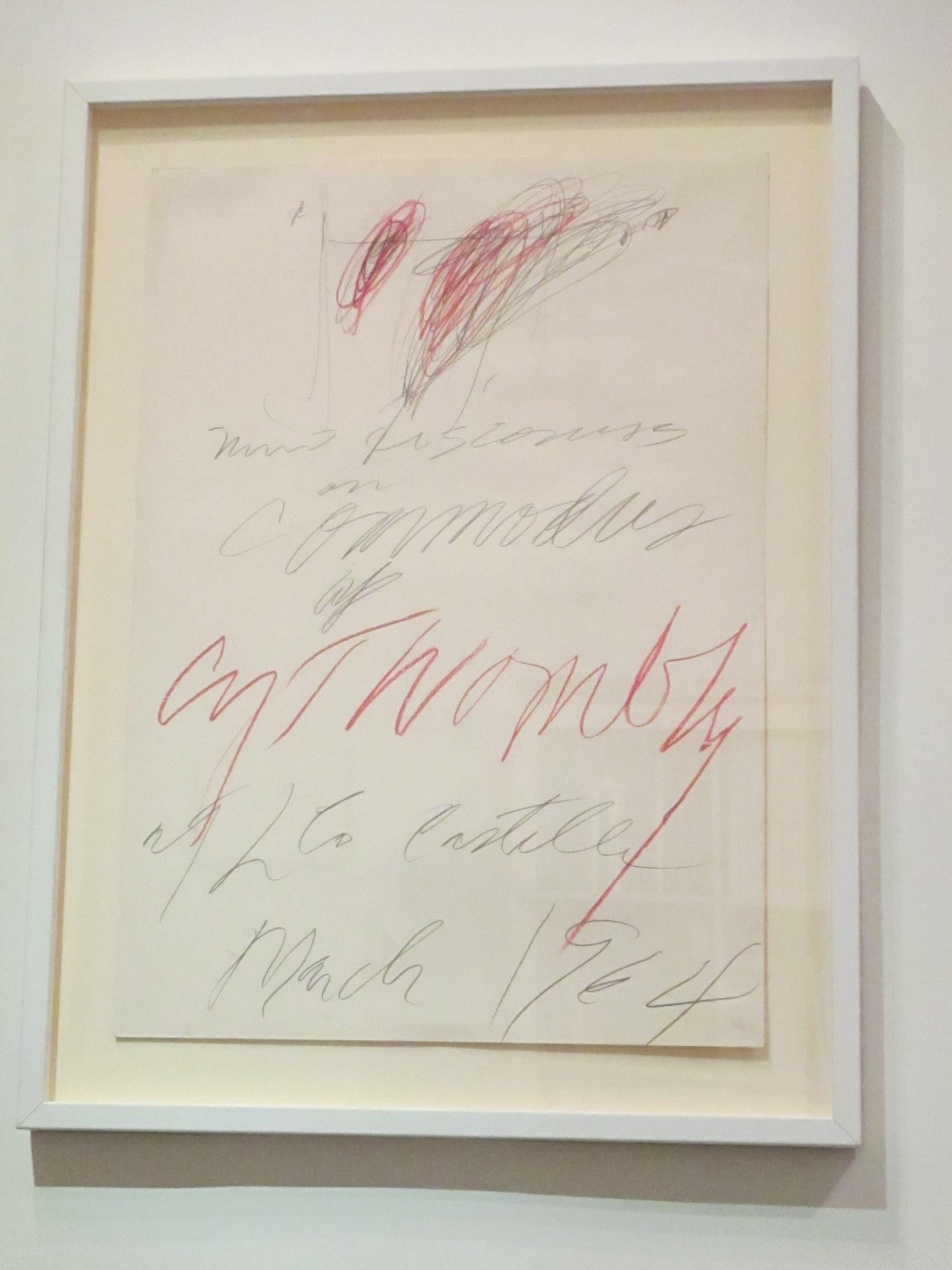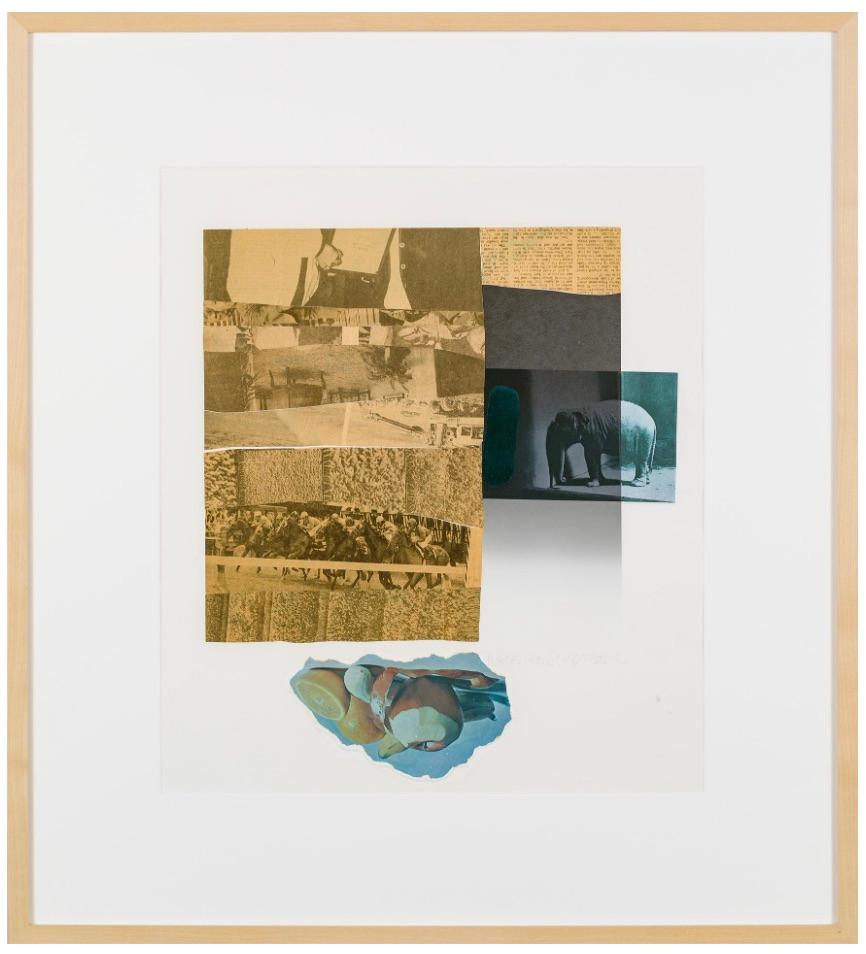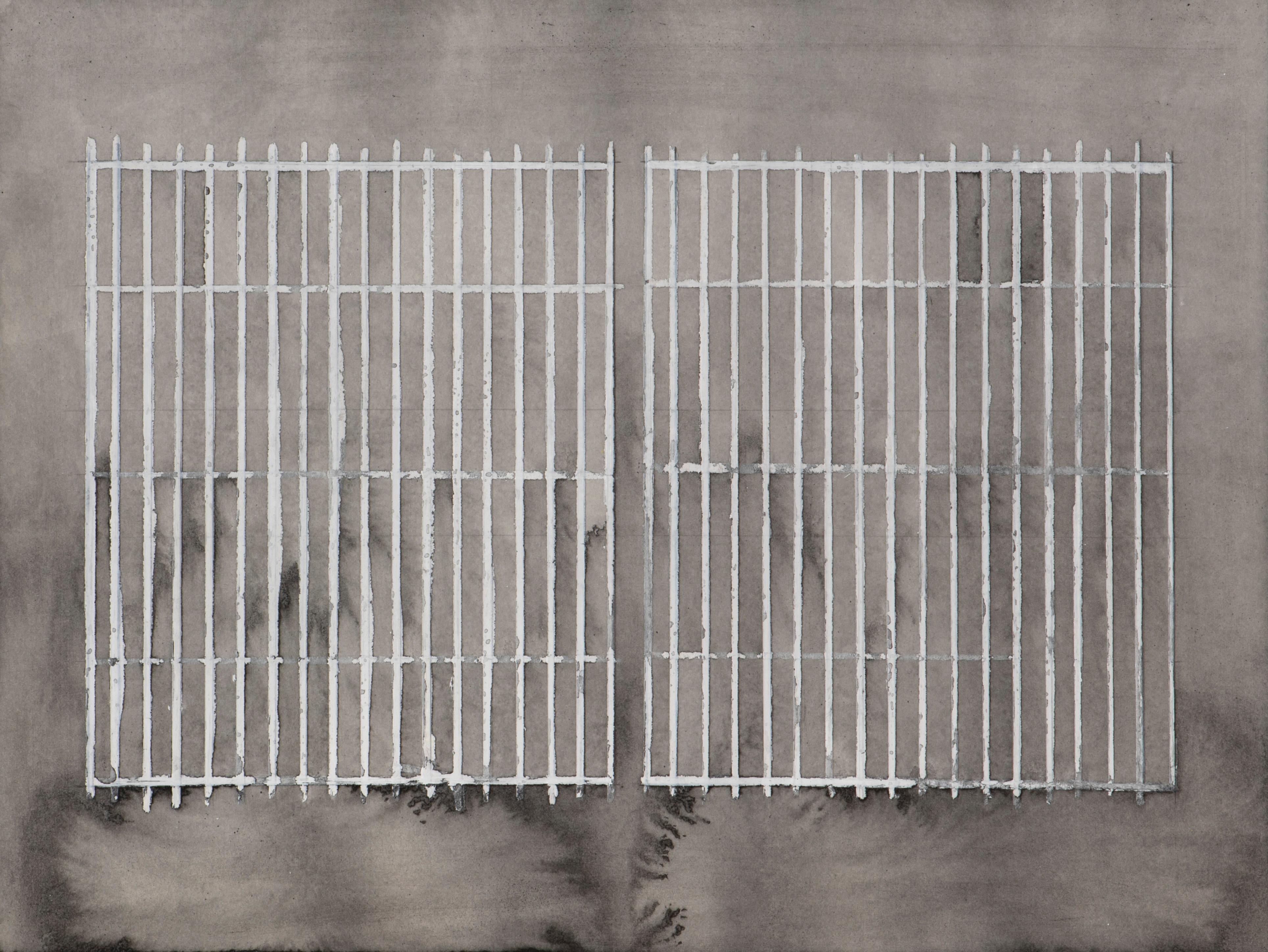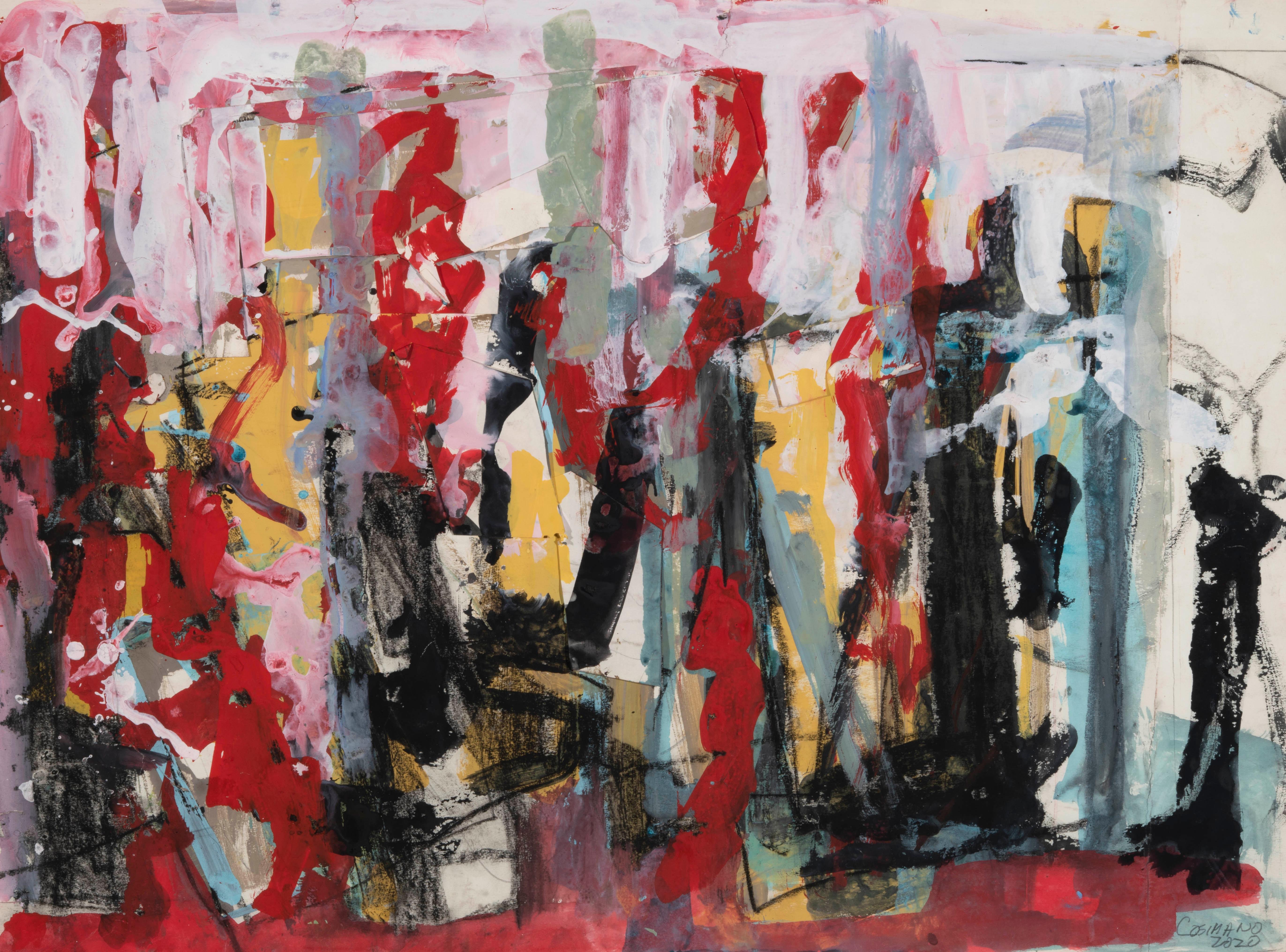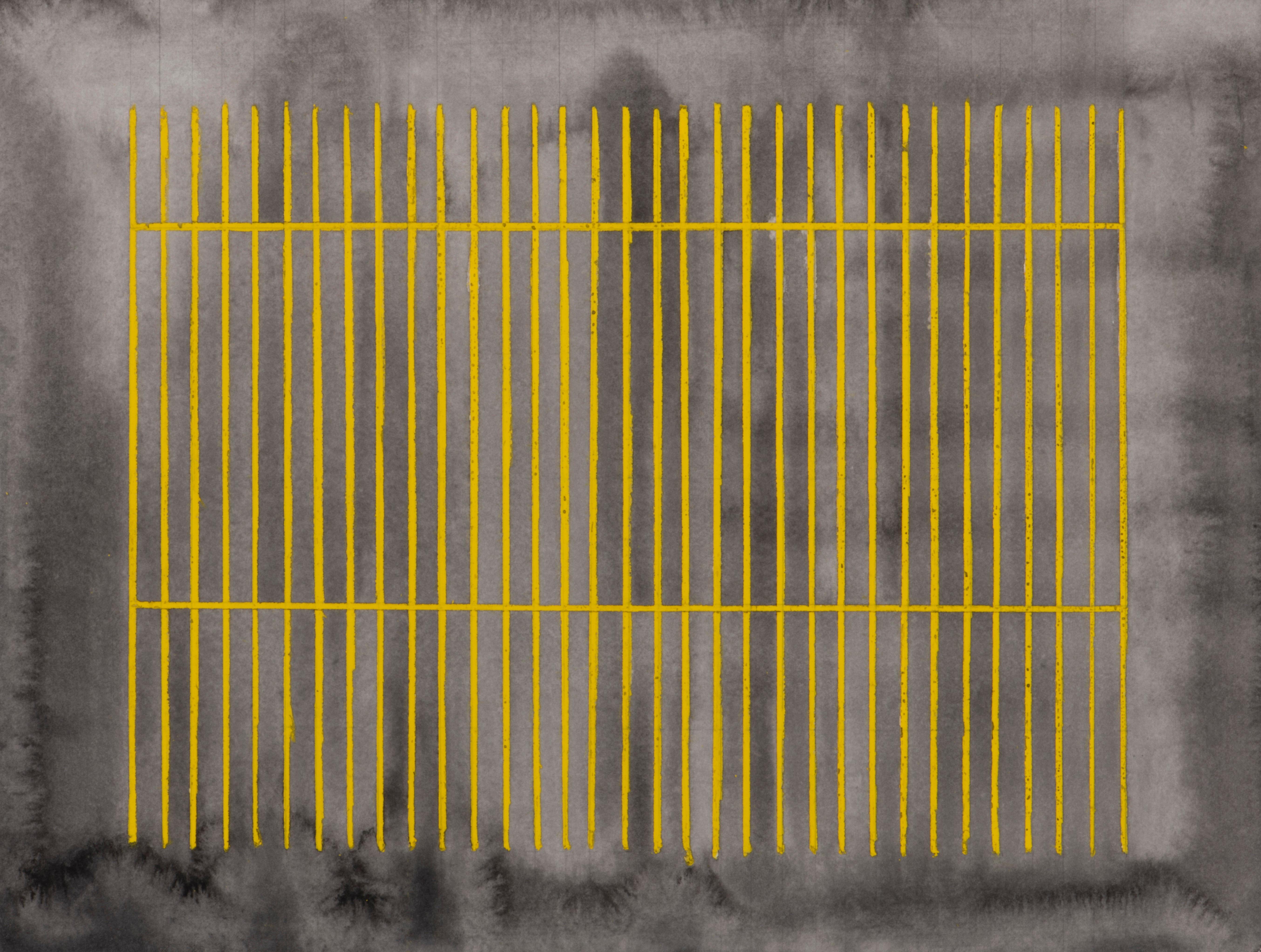Items Similar to British, St. Ives school collage by Sir Terry Frost, dancing figures on red back
Want more images or videos?
Request additional images or videos from the seller
1 of 7
Sir Terry FrostBritish, St. Ives school collage by Sir Terry Frost, dancing figures on red back
About the Item
Terry Frost (British, 1915 – 2003)
Dancing figure
Mixed media Collage
16.1/2 x 18.1/2 in. (42 x 47 cm.) to slip edge
Provenance: Created for and donated to the St. Ives Theatrical Program ‘Kidz R Us’
Beautifully mounted in white, float mounted, behind glass in a simple white slip.
Sir Terry Frost, born in Leamington Spa, in 1915, was one of the most prominent artists of the St Ives School. Despite attending evening classes in art when he was sixteen, until the outbreak of war Frost worked at the manufacturing company Armstrong Whitworth & Co. He was captured in 1941, and sent to a prison camp where he befriended Adrian Heath. In the camp, he made early, crude woodcuts from material that he scrounged, and improvised tools. When Frost returned to England, he attended St Ives School of Art in 1946, under its founder, Leonard Fuller. He then studied at Camberwell School of Art (1947-51; helped by Heath), after long discussion with his wife, Kathleen, whom he had married in 1945. He was taught at Camberwell by Coldstream, who he disliked, and Pasmore, who he found inspirational. Frost’s work had initially been figurative, but, in this period, it became purely abstract. On the advice of Heath, Frost settled in St Ives in 1950, and became part of an influential group of artists, taking over Studio Number 4, next to Ben Nicholson's. He painted the first of his significant Walk Along the Quay series in this year, inspired by the boats that were moored in the harbour. In 1951, Frost was enlisted to help his neighbour, Barbara Hepworth, work on ‘Contrapuntal Forms’, the sculpture that she was to show at the Festival of Britain. The time away from his own studio and work in an unfamiliar medium spurred his later painted constructions and collages. He also met fellow artists Sam Francis and Roger Hilton. The following year, he had his first proper solo exhibition, at the Leicester Galleries. He also became a member of The London Group in 1957. This marked the start of greater recognition, both in Britain and abroad—in 1959, the Tate bought his work Khaki and Lemon (1956), and in 1960 he had a solo show in New York, where he was introduced to prominent Abstract Expressionists. These meetings prompted him to work on larger canvases. He also began to focus more on colour alone, and how it becomes a presence within the work. He developed this in a sculptural form in the 1970s, filling canvas tubes with polystyrene balls, using them to suggest that colour was spilling and twisting from the confines of conventional artworks. From 1952, Frost taught and lectured at various art colleges, including Bath, Coventry, Reading, and Leeds, something he continued to do until his retirement from the University of Reading in 1981. His teaching crucically gave him access to materials, printing presses, and other tools. He also taught overseas, in Canada, Norway, Sweden, Cyprus, and California. These posts obviously involved a significant amount of travel, and in 1974 Frost moved to Newlyn, Cornwall, for good. In 1992 Frost was elected a Royal Academician, and was knighted in 1998. He made a last trip to Venice with John Hoyland in 2001, before he died in 2003, leaving five sons and a daughter. His work remains extremely popular, and its abstract exploration of forms, line, and colour is still fresh and exciting. Shapes, such as the semicircles that interested Ben Nicholson, were a recurring motif throughout Frost’s career. However, each incarnation is innovative and engaging, his paintings invested with movement and a dynamic treatment of form.
- Creator:Sir Terry Frost (1915, British)
- Dimensions:Height: 16.5 in (41.91 cm)Width: 18.5 in (46.99 cm)Depth: 1 in (2.54 cm)
- Medium:
- Movement & Style:
- Period:
- Condition:Overall good order, a few of the figures are possibly frayed. Most of the figures are made from cut card / paper, one is in felt. Many of the figures are applied with blue tack.
- Gallery Location:Petworth, GB
- Reference Number:1stDibs: LU54038029752
About the Seller
4.9
Platinum Seller
These expertly vetted sellers are 1stDibs' most experienced sellers and are rated highest by our customers.
Established in 2010
1stDibs seller since 2017
225 sales on 1stDibs
Typical response time: 3 hours
- ShippingRetrieving quote...Ships From: Petworth, United Kingdom
- Return PolicyA return for this item may be initiated within 10 days of delivery.
More From This SellerView All
- British mid century 3D collage by Cornish artist David Andrew, 2/25Located in Petworth, West SussexA beautiful 3D abstract collage in different materials in muted colours by Cornish artist David Andrew. Andrew was born in Redruth, Cornwall, one of the few internationally recogn...Category
20th Century Abstract Mixed Media
MaterialsPaper
- 1971 Pat Douthwaite Charcoal drawing of a seated man, Scottish, abstractLocated in Petworth, West SussexPat Douthwaite (Scottish, 1939 – 2002) Seated Man Charcoal on paper Indistinctly inscribed, signed and dated ‘Douthwaite 71’ (lower right) 25.1/2 x 18.1/2 in. (64.7 x 47 cm.) Pat Do...Category
20th Century Abstract Figurative Drawings and Watercolors
MaterialsPaper, Charcoal
- Pat Douthwaite Charcoal drawing 'Totem' Scottish, abstractLocated in Petworth, West SussexPat Douthwaite (Scottish, 1939 – 2002) Seated Man Charcoal on paper Indistinctly inscribed, signed and dated ‘Douthwaite 71’ (lower right) 25.1/2 x 18.1/2 in. (64.7 x 47 cm.) Pat Do...Category
20th Century Abstract Figurative Drawings and Watercolors
MaterialsCharcoal, Paper
- Modern British, 1971 abstract ink on paper by Edmond Kapp, caricaturist, redsLocated in Petworth, West SussexEdmond Xavier Kapp (British, 1890 – 1978) No Question! Ink on paper Signed and dated ‘Kapp ‘71’ (lower left), titled on the reverse 14.3/4 x 11.7/8 in. (37.5 x 30.3 cm.) Edmond Kapp was born in Islington, London, on 5 November 1890, of American and German Jewish parentage. He gave himself the middle initial ‘X’ – sometimes said to stand for Xavier – to distinguish himself from his father Emil Kapp, who was a wine merchant. However, his parents called him ‘Eddie’ while his wife and friends knew him as ‘Peter’. During his early years, Kapp was continually ill and, while convalescing, entertained himself by drawing at home. As his health improved, he attended Dame Alice Owen’s School, Islington (1903-10), with periods at Berlin University (1909) and L’Institut Français pour les Etrangers, Paris (1909). He then read Languages at Christ’s College, Cambridge (1910-13), though spent most of his time writing and drawing. Kapp took a studio in London, and worked intensively until the outbreak of the First World War, contributing to the Daily News, the Onlooker and other periodicals. During the war, he served as a 2nd Lieutenant in the Royal Sussex Regiment on the Western Front, and then in Intelligence, rising to the position of Staff Captain on Haig’s Staff. Finally, he founded and directed the Neutral Press Counter-propaganda Section. In 1919, Kapp returned to London and, after abortive periods at three art schools, worked alone. In that year, he made his name with an exhibition of caricatures, held at Furst’s Gallery, London, and accompanied by a catalogue introduced by Max Beerbohm. This soon led to contracts with three London periodicals and a book of caricatures, Personalities, published by Martin Secker. Through the 1920s and 30s, his drawings of musicians...Category
20th Century Abstract Abstract Drawings and Watercolors
MaterialsPaper, Ink
- Sir Eduardo Paolozzi industrial drawings, (2 drawings), 20th Century, ScottishBy Sir Eduardo PaolozziLocated in Petworth, West SussexSir Eduardo Luigi Paolozzi CBE RA (Scottish, 1924 – 2005) Industrial abstract; and another similar Pencil, crayon and ink on paper 8 x 11.1/2 in. (20.3 x 29 cm.) (both)Category
20th Century Abstract Geometric Abstract Drawings and Watercolors
MaterialsPaper, Crayon, Ink, Pencil
- 1950s British black and white abstract by Norman Edgar HubertLocated in Petworth, West SussexNorman Edgar Hubert (British, 1906 – 1985) Geometric abstract in black and white Signed and dated ‘E Hubert 55’ (on the reverse) Gouache on black paper 25.3/8 x 20.3/4 in. (64.3 x 53 cm.) Abstract painter, born Norman Edgar Hubert in Billingshurst, Sussex, and one of the mysterious curiosities of modern British painting. He was at school at Sherborne, and after studying art at University of Reading, 1924–6, was at the Slade School of Fine Art, 1926–9 (gaining a certificate for drawing, 1926–7). Henry Tonks was among his teachers and he shared rooms with William Townsend, in whose journals he appears. Although he socialized with such painters as Geoffrey Tibble, William Coldstream and Rodrigo Moynihan...Category
Mid-20th Century Abstract Abstract Drawings and Watercolors
MaterialsPaper, Gouache
You May Also Like
- Poster Study for “Nine Discourses on Commodus"By Cy TwomblyLocated in Beverly Hills, CACy Twombly Poster Study for “Nine Discourses on Commodus by Cy Twombly at Leo Castelli” Pencil and colored pencil on paper 27 5/8 x 19 ¾ inches ...Category
1960s Abstract Mixed Media
MaterialsPaper, Pencil, Color Pencil
- Horsefeather Thirteen XBy Robert RauschenbergLocated in Washington Depot,, CTlithograph and screenprint with pochoir collage and embossing on paperCategory
1970s Abstract Expressionist Mixed Media
MaterialsPaper, Lithograph, Screen
- Untitled (Līnea Study), 2022Located in Washington, DCOriginal work by Mary Early. Graphite, colored pencil, and sumi ink on Arches paper, 12.25 x 16". "The production, or “pouring,” of beeswax elements has become a meditative process that is integral to my art practice, serving as an observation of time, materials, and space. The raw beeswax I use has taken its form at the end of a long series of natural processes followed by a manufacturing process, and once it is in my hands, the studio becomes a factory. I apply my own methods of transforming the material by casting the beeswax into three-dimensional forms. Once I have fixed both a place and a time in the future for a potential installation, I begin to determine how the beeswax lines will take their aggregated shape in that space and, simultaneously, how many lines might be manufactured for that particular space in the amount of time available." Mary Early (born 1975, Washington, DC) lives and works in Washington, DC. She studied visual art, film, and video at Bennington College, and her work has been exhibited at the United States Botanic Garden, Washington Project for the Arts, the Corcoran Gallery of Art, Second Street Gallery (Charlottesville, VA), Hemphill Fine Arts (Washington DC,) the Austrian Cultural Forum (Washington DC), Galerie Im Ersten (Vienna, Austria), Kloster Schloss Salem (Salem, Germany), Kunstlerbund Tubingen (Tubingen, Germany), and the American University Museum (Washington DC) among other regional and national galleries. Her early work incorporated formed concrete, tarpaper and paraffin wax, fabricated wood structures, and, increasingly over the years, surfaces coated with wax as a method of preserving or concealing an object within. Recent works have relied solely on solid forms cast in wax, abandoning the use of any permanent armature. Temporary installations are guided by schematic drawings and plans, which then serve as a permanent record. In 2014 she exhibited her first large-scale installation of wax lines at Second Street Gallery in Charlottesville, VA, followed by temporary installations in response to various historical sites in Salem, Germany (2016) and Tubingen Germany (2017). In 2017 she participated in the exhibition “Twist-Layer-Pour” at the American University Museum, which included Untitled [Curve], an installation of thousands of beeswax lines assembled on the floor of the museum. In spring 2018 she was commissioned to create a temporary installation at the Sun Valley Center for the Arts, Sun Valley Idaho. This work took the form of two intersecting curtains of hanging beeswax lines bisecting a 12’ foot x 18’ foot room, providing an immersive and enclosed viewing space. Early’s work is included in the collections of the US Department of State/Embassy of Panama, Kimpton Hotels, and the District of Columbia Art Bank among other public and private collections. She is a recipient of the Artist Fellowship Grant from the DC Commission on Arts & Humanities, Washington DC (2020, 2019, 2018, 2017, 2016, 2015, 2014, 2011, 2009, 2007). Early is the director of HEMPHILL Fine Arts, Washington, DC, and serves on the boards of Hamiltonian Artists and Washington Sculptors Group. She handles the work of contemporary artists and artist estates, including the work of William Christenberry, Colby Caldwell, Hedieh Javanshir Ilchi, Linling Lu, Mingering Mike, Robin Rose, Renée Stout...Category
21st Century and Contemporary Abstract Geometric Mixed Media
MaterialsSumi Ink, Archival Paper, Graphite, Wax Crayon
- Disco InfernoLocated in Washington, DCPainting titled "Disco Inferno" by Jeanne Cosimano. Wonderful vibrant painting is gouache on paper and dated 2020. Frame is included. This work was recently featured in a solo show at Gallery 2112...Category
21st Century and Contemporary Abstract Expressionist Abstract Paintings
MaterialsGouache, Archival Paper
- Untitled (Study for Līnea)Located in Washington, DCPoured beeswax work by Mary Early from her "Study for Līnea" series. "The production, or “pouring,” of beeswax elements has become a meditative process that is integral to my art practice, serving as an observation of time, materials, and space. The raw beeswax I use has taken its form at the end of a long series of natural processes followed by a manufacturing process, and once it is in my hands, the studio becomes a factory. I apply my own methods of transforming the material by casting the beeswax into three-dimensional forms. Once I have fixed both a place and a time in the future for a potential installation, I begin to determine how the beeswax lines will take their aggregated shape in that space and, simultaneously, how many lines might be manufactured for that particular space in the amount of time available." Mary Early (born 1975, Washington, DC) lives and works in Washington, DC. She studied visual art, film, and video at Bennington College, and her work has been exhibited at the United States Botanic Garden, Washington Project for the Arts, the Corcoran Gallery of Art, Second Street Gallery (Charlottesville, VA), Hemphill Fine Arts (Washington DC,) the Austrian Cultural Forum (Washington DC), Galerie Im Ersten (Vienna, Austria), Kloster Schloss Salem (Salem, Germany), Kunstlerbund Tubingen (Tubingen, Germany), and the American University Museum (Washington DC) among other regional and national galleries. Her early work incorporated formed concrete, tarpaper and paraffin wax, fabricated wood structures, and, increasingly over the years, surfaces coated with wax as a method of preserving or concealing an object within. Recent works have relied solely on solid forms cast in wax, abandoning the use of any permanent armature. Temporary installations are guided by schematic drawings and plans, which then serve as a permanent record. In 2014 she exhibited her first large-scale installation of wax lines at Second Street Gallery in Charlottesville, VA, followed by temporary installations in response to various historical sites in Salem, Germany (2016) and Tubingen Germany (2017). In 2017 she participated in the exhibition “Twist-Layer-Pour” at the American University Museum, which included Untitled [Curve], an installation of thousands of beeswax lines assembled on the floor of the museum. In spring 2018 she was commissioned to create a temporary installation at the Sun Valley Center for the Arts, Sun Valley Idaho. This work took the form of two intersecting curtains of hanging beeswax lines bisecting a 12’ foot x 18’ foot room, providing an immersive and enclosed viewing space. Early’s work is included in the collections of the US Department of State/Embassy of Panama, Kimpton Hotels, and the District of Columbia Art Bank among other public and private collections. She is a recipient of the Artist Fellowship Grant from the DC Commission on Arts & Humanities, Washington DC (2020, 2019, 2018, 2017, 2016, 2015, 2014, 2011, 2009, 2007). Early is the director of HEMPHILL Fine Arts, Washington, DC, and serves on the boards of Hamiltonian Artists and Washington Sculptors Group. She handles the work of contemporary artists and artist estates, including the work of William Christenberry, Colby Caldwell, Hedieh Javanshir Ilchi, Linling Lu, Mingering Mike, Robin Rose, Renée Stout...Category
21st Century and Contemporary Abstract Geometric Mixed Media
MaterialsWax Crayon, Sumi Ink, Archival Paper, Graphite
- Untitled (Līnea Study), 2022Located in Washington, DCOriginal work by Mary Early. Graphite, wax crayon, and sumi ink on Arches paper, 12.25 x 16". "The production, or “pouring,” of beeswax elements has become a meditative process that is integral to my art practice, serving as an observation of time, materials, and space. The raw beeswax I use has taken its form at the end of a long series of natural processes followed by a manufacturing process, and once it is in my hands, the studio becomes a factory. I apply my own methods of transforming the material by casting the beeswax into three-dimensional forms. Once I have fixed both a place and a time in the future for a potential installation, I begin to determine how the beeswax lines will take their aggregated shape in that space and, simultaneously, how many lines might be manufactured for that particular space in the amount of time available." Mary Early (born 1975, Washington, DC) lives and works in Washington, DC. She studied visual art, film, and video at Bennington College, and her work has been exhibited at the United States Botanic Garden, Washington Project for the Arts, the Corcoran Gallery of Art, Second Street Gallery (Charlottesville, VA), Hemphill Fine Arts (Washington DC,) the Austrian Cultural Forum (Washington DC), Galerie Im Ersten (Vienna, Austria), Kloster Schloss Salem (Salem, Germany), Kunstlerbund Tubingen (Tubingen, Germany), and the American University Museum (Washington DC) among other regional and national galleries. Her early work incorporated formed concrete, tarpaper and paraffin wax, fabricated wood structures, and, increasingly over the years, surfaces coated with wax as a method of preserving or concealing an object within. Recent works have relied solely on solid forms cast in wax, abandoning the use of any permanent armature. Temporary installations are guided by schematic drawings and plans, which then serve as a permanent record. In 2014 she exhibited her first large-scale installation of wax lines at Second Street Gallery in Charlottesville, VA, followed by temporary installations in response to various historical sites in Salem, Germany (2016) and Tubingen Germany (2017). In 2017 she participated in the exhibition “Twist-Layer-Pour” at the American University Museum, which included Untitled [Curve], an installation of thousands of beeswax lines assembled on the floor of the museum. In spring 2018 she was commissioned to create a temporary installation at the Sun Valley Center for the Arts, Sun Valley Idaho. This work took the form of two intersecting curtains of hanging beeswax lines bisecting a 12’ foot x 18’ foot room, providing an immersive and enclosed viewing space. Early’s work is included in the collections of the US Department of State/Embassy of Panama, Kimpton Hotels, and the District of Columbia Art Bank among other public and private collections. She is a recipient of the Artist Fellowship Grant from the DC Commission on Arts & Humanities, Washington DC (2020, 2019, 2018, 2017, 2016, 2015, 2014, 2011, 2009, 2007). Early is the director of HEMPHILL Fine Arts, Washington, DC, and serves on the boards of Hamiltonian Artists and Washington Sculptors Group. She handles the work of contemporary artists and artist estates, including the work of William Christenberry, Colby Caldwell, Hedieh Javanshir Ilchi, Linling Lu, Mingering Mike, Robin Rose, Renée Stout...Category
21st Century and Contemporary Abstract Geometric Mixed Media
MaterialsArchival Paper, Graphite, Wax Crayon, Sumi Ink
